RNA∶DNA Hybrids Initiate Quasi-Palindrome-Associated Mutations in Highly Transcribed Yeast DNA
RNase H enzymes promote genetic stability by degrading aberrant RNA∶DNA hybrids and by removing ribonucleotide monophosphates (rNMPs) that are present in duplex DNA. Here, we report that loss of RNase H2 in yeast is associated with mutations that extend identity between the arms of imperfect inverted repeats (quasi-palindromes or QPs), a mutation type generally attributed to a template switch during DNA synthesis. QP events were detected using frameshift-reversion assays and were only observed under conditions of high transcription. In striking contrast to transcription-associated short deletions that also are detected by these assays, QP events do not require Top1 activity. QP mutation rates are strongly affected by the direction of DNA replication and, in contrast to their elevation in the absence of RNase H2, are reduced when RNase H1 is additionally eliminated. Finally, transcription-associated QP events are limited by components of the nucleotide excision repair pathway and are promoted by translesion synthesis DNA polymerases. We suggest that QP mutations reflect either a transcription-associated perturbation of Okazaki-fragment processing, or the use of a nascent transcript to resume replication following a transcription-replication conflict.
Published in the journal:
RNA∶DNA Hybrids Initiate Quasi-Palindrome-Associated Mutations in Highly Transcribed Yeast DNA. PLoS Genet 9(11): e32767. doi:10.1371/journal.pgen.1003924
Category:
Research Article
doi:
https://doi.org/10.1371/journal.pgen.1003924
Summary
RNase H enzymes promote genetic stability by degrading aberrant RNA∶DNA hybrids and by removing ribonucleotide monophosphates (rNMPs) that are present in duplex DNA. Here, we report that loss of RNase H2 in yeast is associated with mutations that extend identity between the arms of imperfect inverted repeats (quasi-palindromes or QPs), a mutation type generally attributed to a template switch during DNA synthesis. QP events were detected using frameshift-reversion assays and were only observed under conditions of high transcription. In striking contrast to transcription-associated short deletions that also are detected by these assays, QP events do not require Top1 activity. QP mutation rates are strongly affected by the direction of DNA replication and, in contrast to their elevation in the absence of RNase H2, are reduced when RNase H1 is additionally eliminated. Finally, transcription-associated QP events are limited by components of the nucleotide excision repair pathway and are promoted by translesion synthesis DNA polymerases. We suggest that QP mutations reflect either a transcription-associated perturbation of Okazaki-fragment processing, or the use of a nascent transcript to resume replication following a transcription-replication conflict.
Introduction
RNA∶DNA hybrids exist as normal intermediates during the cellular transactions of transcription and DNA replication. During transcription, a small segment of the nascent RNA is transiently base-paired with the template DNA strand as part of a transcription bubble. More extensive and stable hybrids between RNA transcripts and the DNA template (an R-loop), however, can form under certain conditions (reviewed in [1], [2], [3]). Impediments to the transcription process such as disruption of co-transcriptional mRNA packaging or a failure to remove negative superhelical stress in the transcribed region favor the formation of R-loops. RNA∶DNA hybrids also form during genome replication, especially during synthesis of the lagging strand, which occurs discontinuously as a series of ∼200 nt Okazaki fragments (reviewed in [4], [5]). Each Okazaki fragment is initiated by a complex of DNA polymerase α (Pol α) and primase, which together synthesize primers comprised of ∼10 ribonucleotide monophosphates followed by ∼20 deoxyribonucleotide monophosphates (rNMPs and dNMPs, respectively). Following a polymerase switch to Pol δ, the primary lagging-strand polymerase, primers are extended to complete Okazaki-fragment synthesis. Finally, RNA primers are removed by Pol δ-mediated strand displacement coupled with flap processing.
In addition to forming in association with transcription and replication, RNA∶DNA hybrids can also arise from the stochastic incorporation of rNMPs by DNA polymerases. Replicative DNA polymerases are highly selective in discriminating between rNTP and dNTP substrates, but nevertheless utilize rNTPs at a low level during DNA synthesis. In Saccharomyces cerevisiae, it has been estimated that Pol δ and Pol ε incorporate 1 rNMP for every 1,250 or 5,000 dNMPs, respectively [6]. In combination with Pol α, which has lower sugar discrimination than either Pol δ or Pol ε, there likely are >10,000 rNMPs incorporated during each round of haploid genome duplication. Though this generally is assumed to result in single rNMPs embedded in otherwise duplex DNA, tandem rNMPs could also be incorporated. In mammals, rNMPs are found at more than 1,000,000 sites per genome, suggesting that rNMPs are the most abundant type of endogenous DNA “lesion” [7].
RNA∶DNA hybrids are a serious threat to genome stability and are removed by the RNase H class of enzymes, which specifically degrade the RNA component (reviewed in [8]). RNase H1 is a single-subunit enzyme; it requires at least four contiguous rNMPs for cleavage of RNA∶DNA hybrids in vitro [9], [10] and is essential for the replication of mitochondrial DNA [11]. RNase H2 is a three-subunit enzyme that is highly expressed in proliferative mammalian tissues [7] and, in addition to its ability to process R-loops and Okazaki fragments, has the unique ability to incise at a single rNMP within otherwise duplex DNA [10], [12], [13]. Persistent R-loops interfere with replication during mitosis and meiosis, leading to accumulation of DNA breaks, especially at highly transcribed and/or repetitive sequences (reviewed in [1]). A failure to remove lagging-strand primers and complete Okazaki-fragment maturation likewise results in hyper-recombination, chromosomal instability, hyper-sensitivity to DNA damaging agents and reduced cell viability [14]. In the absence of RNase H2, accumulation of single (or a small number of) rNMPs in genomic DNA also leads to cell-cycle defects and chromosomal instability [7], [15]. Though neither RNase H1 nor H2 is essential in yeast, both are required for mammalian cell viability and embryonic development [7], [11]. Significantly, hypomorphic alleles of genes encoding RNase H2 subunits are associated with the hereditary, early-onset neuro-inflammatory disease Aicardi-Goutières syndrome [16].
In addition to gross chromosomal effects, persistent rNMPs in DNA elevate mutagenesis. There is a dramatic increase in deletions occurring within short tandem repeats in yeast strains deficient in RNase H2 [17], [18], [19], and a similar mutation signature is found in highly transcribed sequences [20]. The deletions in both cases require activity of the yeast Type 1B topoisomerase (Top1), an enzyme that relieves transcription-associated torsional stress in DNA (reviewed in [21]). The first step in a Top1-catalyzed reaction is generation of a transient single-strand break in the DNA backbone, with the enzyme linking itself to the 3′ end of the break via a covalent phosphotyrosyl bond. Following rotation of the broken strand around the intact strand, the Top1-generated nick is resealed and the enzyme is released in a self-catalytic reaction with the hydroxyl group on the 5′ side of the break. When the initial Top1 cleavage occurs at an rNMP, however, the 2′ hydroxyl group of the ribose can attack the phosphotyrosyl bond. This results in release of Top1 from DNA and leaves behind a nick flanked by a 2′,3′ cyclic phosphate and a 5′-OH [22]. We have proposed that when Top1 cleaves at an rNMP, either further processing of the dirty ends thus created or a subsequent cleavage-ligation cycle by Top1 results in short deletions [19]. The significance of the tandem repeat in the deletion process is that it provides an opportunity for strand misalignment, which converts a gapped intermediate into a more efficiently ligated nick. That rNMP-dependent deletions reflect Top1 incision at a single rNMP was recently confirmed using a mutant RNase H2 that retains only the ability to nick at tandem rNMPs [10].
In the current study, we describe a new type of transcription-associated mutation that is greatly elevated in RNase H2-deficient yeast strains. The relevant mutations occur at imperfect inverted repeats or quasi-palindromes and, in striking contrast to deletions in tandem repeats, do not require Top1 activity. Genetic analyses demonstrate a strong effect of the direction of replication fork movement as well as roles for translesion synthesis DNA polymerases and RNase H1 in generating these novel, Top1-independent events. We suggest that, in absence of functional RNase H2, RNase H1 generates potentially mutagenic roadblocks at sites of incompletely processed RNA∶DNA hybrids.
Results
Frameshift reversion assays
In order to obtain a variety of rNMP-dependent mutations, the reversion of three frameshift alleles that query an ∼150 bp sequence was monitored: lys2ΔBgl, lys2ΔA746 and lys2ΔA746,NR. The lys2ΔBgl allele was constructed by filling in BglII-generated 5′ overhangs to generate a 4-bp duplication, the equivalent of a +1 frameshift mutation [23]. Reversion to lysine prototrophy requires acquisition of a compensatory net −1 frameshift mutation within a window defined by stop codons in the alternative reading frames. The lys2ΔA746 allele contains an engineered 1-bp deletion in the same region of LYS2 and requires a compensatory net +1 frameshift mutation for reversion [24]. Finally, the lys2ΔA746,NR allele was derived from the lys2ΔA746 allele by disrupting mononucleotide runs in the reversion window that were longer than 3 bp [25]. For the lys2ΔA746 and lys2ΔA746,NR alleles, transcription was driven by either the endogenous LYS2 promoter or by a tetracycline/doxycycline-repressible promoter (pTET) to achieve low- or high-transcription conditions, respectively. For the lys2ΔBgl allele, the pTET promoter was fully active in the absence of doxycycline or was repressed to a low level by addition of doxycycline to the growth medium.
Transcription-associated mutations accumulate at a quasi-palindrome in the absence of RNase H2 and are Top1 independent
Loss of RNase H2 under low-transcription conditions is associated with only small changes in mutation rate, but can be accompanied by striking changes in mutation spectra [17], [26]. Mutation types that are specifically enriched in the absence of Rnh201, the catalytic subunit of RNase H2, will be designated here as rNMP-dependent mutations. In the lys2ΔBgl assay, RNase H2 loss is associated with reversion via deletion of one copy of an (AGCT)2 tandem repeat [26]. We previously demonstrated that the rate of this rNMP-dependent, 4-bp deletion (highlighted gray in Figure 1A) is greatly elevated under high-transcription conditions and that it requires the presence of Top1 [18], [19]. Specifically under high-transcription conditions, disruption of RNase H2 also resulted in a 100-fold increase in “complex” events, which are defined as mutations with multiple changes. These events occurred at a discrete hotspot (highlighted yellow in Figure 1A; see Table 1 for rates) and, in striking contrast to 4-bp deletions, their rates were not affected by Top1 loss (Table 1).
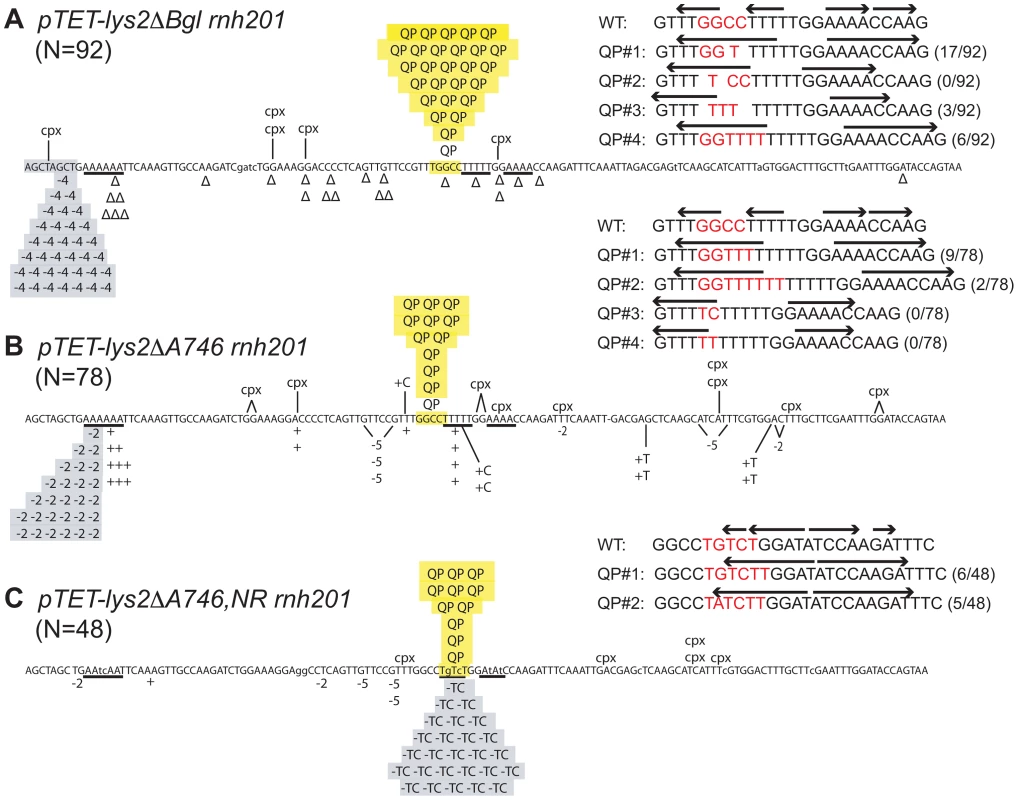
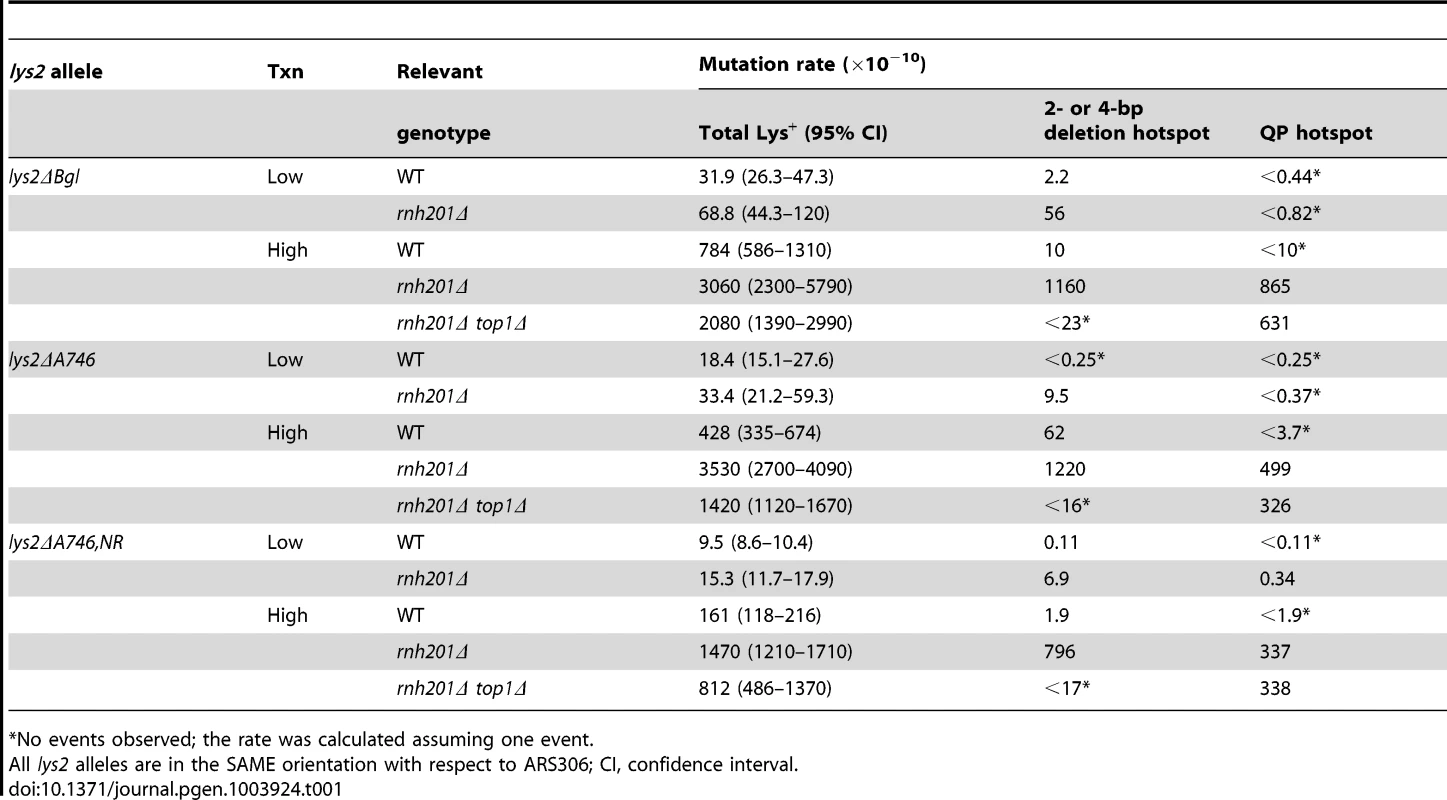
Figure 1A shows sequence changes in four types of rNMP-dependent complex mutations at the hotspot detected in the lys2ΔBgl assay, each of which replaces all or part of a common GGCC sequence with one or more thymines. Significantly, this region contains two 4-bp inverted repeats (IRs) that together comprise a larger, imperfect IR or quasi-palindrome (QP). On the nontranscribed (coding) strand, the upstream segment of the QP is 5′ TTGGccTTTT (the lowercase letters are spacers between the smaller IRs), and the downstream segment is 5′-AAAACCAA; the two arms of the QP are separated by 3 bp. Each of the complex mutations generated a perfect IR that ranges in size from 5–8 bp, with the most frequent event generating an 8-bp palindrome. Hereafter, the transcription- and rNMP-dependent mutations originally designated as complex events will be referred to as QP mutations.
In the lys2ΔA746 assay, RNH201 deletion elevated the reversion rate 1.8-fold under low-transcription conditions (Table 1; [19]) and 2-bp deletions within a 6A run comprised ∼30% of reversion events (highlighted gray in Figure 1B). Under high-transcription conditions, 2-bp deletions at the 6A hotspot were prominent even in the presence of RNase H2, and were elevated an additional 20-fold in an rnh201Δ background. Like the 4-bp deletions detected in the lys2ΔBgl assay, 2-bp deletions in the 6A run were Top1 dependent. Also observed specifically under high-transcription conditions in the rnh201Δ background were QP mutations that localized to the same region as those in the lys2ΔBgl assay (highlighted yellow in Figure 1B). As in the lys2ΔBgl assay, QP mutation rates in the lys2ΔA746 assay were not reduced when TOP1 was deleted from the rnh201Δ background.
In the case of the lys2ΔA746,NR allele, deletion of RNH201 under low-transcription conditions was accompanied by the appearance of a novel 2-bp deletion hotspot in which TC was deleted from the imperfect dinucleotide repeat, TGTCTG (events are highlighted gray in Figure 1C; see Table 1). The TGTCTG repeat is unique to the lys2ΔA746,NR allele and was generated during elimination of a 5T run (TTTTT changed to TgTcT) that overlaps the QP mutation hotspot in the lys2ΔA746 and lys2ΔBgl assays. The TC deletions were elevated an additional 100-fold by high transcription, and like the short deletions in perfect tandem repeats, were dependent on Top1. In addition to TC deletions in the TGTCTG repeat, there were two types of rNMP-dependent +1 frameshift events at the same location, and these were observed only under high-transcription conditions (highlighted yellow in Figure 1C). One involved insertion of a T into the imperfect tandem repeat (TGTCTG changed to TGTCtTG), while the other was comprised of the same T insertion plus a nearby G to A transition (TGTCTG changed to TaTCtTG). Although the primary sequence of the lys2ΔA746,NR allele is slightly different from that of the lys2ΔBgl and lys2ΔA746 alleles, a similar pattern of converting a QP to a perfect palindrome was evident. In this case, the arms of the QP are 5′-TCTGGAT and 5′-ATCCAaGA (the lowercase letter interrupts the palindrome); addition of a T (complementary to the disrupting “a” in the downstream arm) with or without an accompanying base change generates a perfect 8- or 9-bp palindrome, respectively (Figure 1C). As observed in the lys2ΔBgl and lys2ΔA746 assays, QP mutations detected in the lys2ΔA746,NR assay were not affected by Top1 loss (Table 1). In summary, each frameshift reversion assay identified two distinct types of rNMP- and transcription-dependent mutations: Top1-dependent deletions in tandem repeats and Top1-independent events in quasi-palindromes.
QP mutations are decreased when RNase H1 is eliminated
The potential in vivo substrates of RNase H2 include rNMPs mis-incorporated into duplex DNA [17], the RNA primers at the 5′ ends of Okazaki fragments ([27], [28] and reviewed in [5]) and the RNA component of R-loops [8]. Though RNase H1 can neither incise at single rNMPs embedded in DNA [10] nor substitute for RNase H2 in a reconstituted ribonucleotide excision repair assay [13], it does share the other two types of RNA∶DNA substrates with RNase H2. To ascertain the type of RNA∶DNA hybrid that is relevant to QP mutations, we examined the effect of eliminating RNase H1 in addition to RNase H2. If only one or a few rNMPs is relevant to QP mutations, then disruption of RNase H1 in an rnh201Δ background would be expected to have no effect on these events. If it is multiple rNMPs that are relevant, however, then QP mutations should be further elevated upon additional loss of RNase H1. Unexpectedly, the rates of QP mutations in each frameshift-reversion assay were reduced at least 10-fold in the rnh201Δ rnh1Δ double- relative to the rnh201Δ single-mutant background (Figure 2A). As expected, the rates of Top1-dependent deletions at the tandem-repeat hotspots were not affected by additional deletion of RNH1 in an rnh201Δ background (Figure 2B).
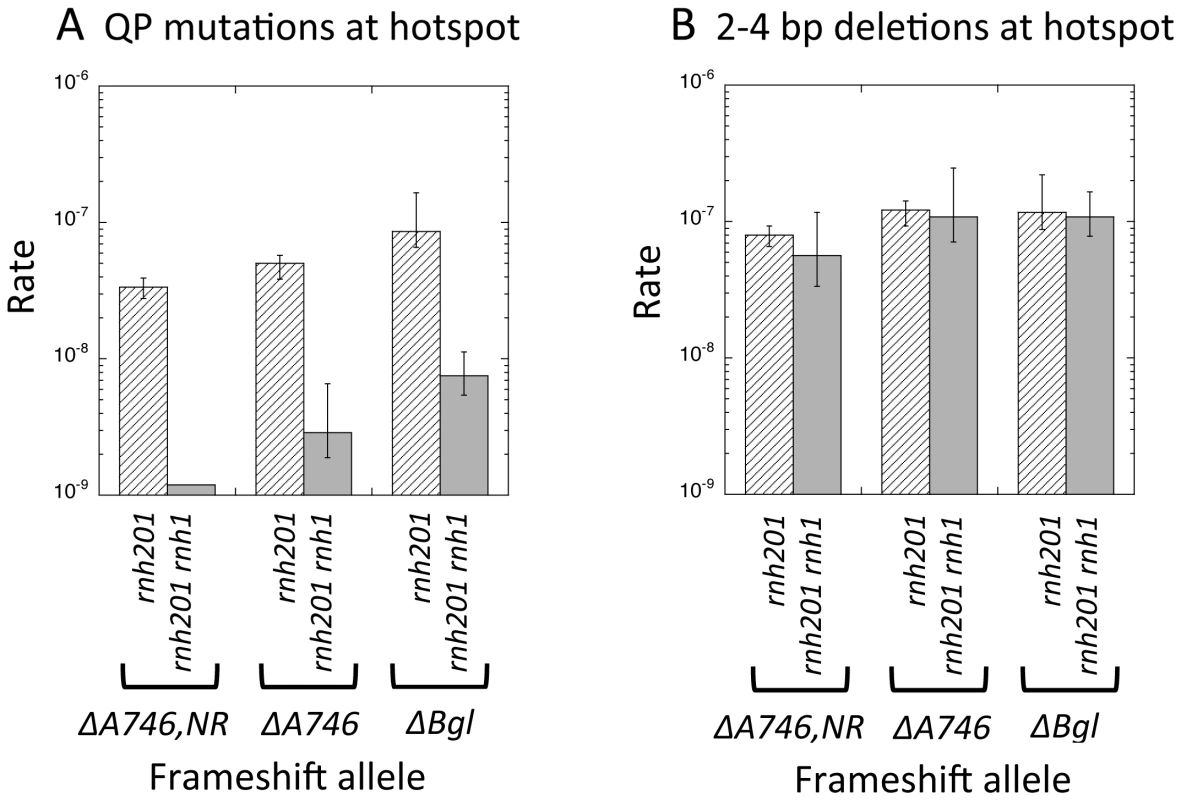
The opposing effects of RNase H1 and RNase H2 loss on QP mutations (reducing and enhancing these events, respectively) indicate that extensive RNA∶DNA hybrids, as well the few rNMPs that may remain after their processing, are relevant. Studies using mutant forms of Pol2 that have altered rNTP discrimination suggest that most rNMPs in yeast genomic DNA are incorporated by Pol ε, the leading-strand polymerase. To explore whether Pol ε might be the source of the rNMPs that initiate transcription-associated QP mutations, we introduced the rNTP-restrictive Pol2-M644L protein [6] into an rnh201Δ top1Δ background. Expression of the Pol2-M644L protein had no effect on the rates of QP mutations in either the lys2ΔA746,NR or lys2ΔA746 assay (Tables S1, S2). These data suggest that the rNMPs that trigger QP mutations do not reflect aberrant incorporation by Pol ε, and likely are derived either from Okazaki fragment primers or from R-loops.
QP mutations are affected by the direction of DNA replication
QP mutations have been proposed to occur via a template switch between the two arms of the QP during DNA synthesis (for reviews, see [29], [30]). In principle, this can involve either an intra- or an inter-molecular switch, each of which is illustrated in Figure 3 for the most common QP event observed in the lys2ΔBgl assay. Intra-molecular switches are thought to occur primarily during lagging-strand synthesis, where the single-strand nature of the template strand may contribute to hairpin formation and promote the initial template switch [31]. In the case of inter-molecular switches, data suggest that the nascent leading strand switches to the lagging-strand template, a switch that similarly may be facilitated by the extensive tracts of single-strand DNA formed between Okazaki fragments [32]. In either case, there are two switches: the first to an alternative template that is used to direct very limited DNA synthesis, and a second switch back to the original template.
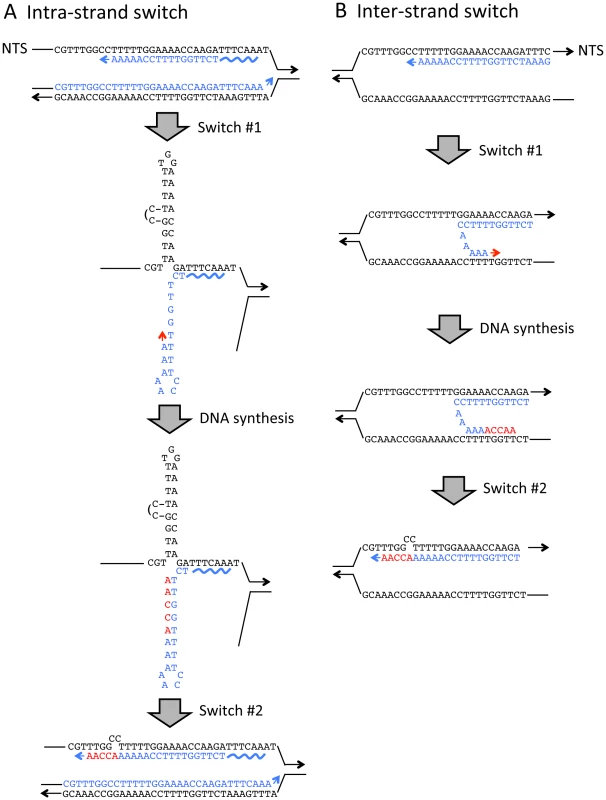
Because the rate of a given QP mutation is often affected by the direction of DNA replication, it has been suggested that the corresponding intermediate is generated primarily during either leading-or lagging-strand synthesis [32], [33]. In all of the strains used here, the resident LYS2 locus on Chromosome II was deleted and lys2 frameshift alleles were positioned on Chromosome III near the early-firing replication origin ARS306 [34]. When in the SAME orientation, which is the orientation used to generate the data in Table 1 and Figure 1, the lys2 allele is oriented so that transcription from pTET is co-directional with the direction of replication fork movement from ARS306. In this orientation, the non-transcribed strand (NTS) of lys2 is the lagging-strand template during DNA replication (Figure 3A). When in the OPPO orientation, the transcription and replication forks converge and the NTS strand is the leading-strand template (Figure 3B). To determine whether the direction of replication fork movement affects rNMP-dependent QP mutations, we compared their rates in SAME and OPPO strains. The direction of replication had a profound effect on QP mutation rates in each assay; when lys2 alleles were in the SAME orientation, rates were at least 10-fold higher than when in the OPPO orientation (Table 2). As reported previously, the direction of DNA replication had no effect on overall levels of transcription-associated mutagenesis in a WT background, and only a subtle (at most 2-fold) effect on Top1-dependent deletions in tandem repeats (Table 2).
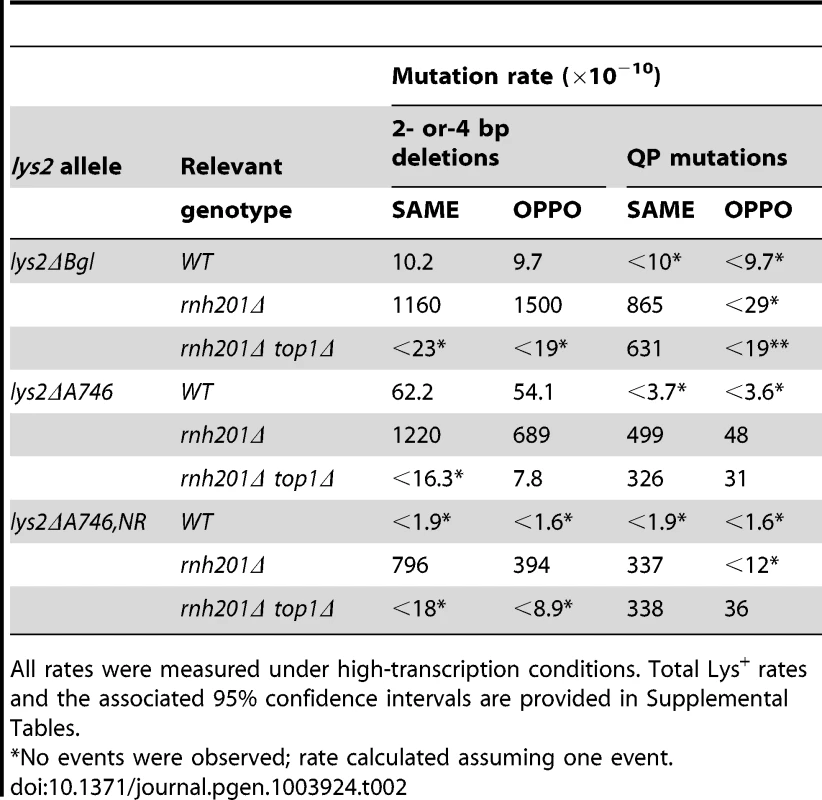
The sensitivity of QP mutations to the direction of DNA replication is consistent with strand switching that is triggered preferentially during either leading- or lagging-strand synthesis. Indeed, QP mutations in the E. coli genome are greatly elevated in the absence of mismatch repair (MMR), consistent with temporal connection of these events to replication fork movement [35]. To assess whether transcription-associated QP mutations in yeast are similarly limited by the MMR system, we examined reversion of the lys2ΔA746 and lys2ΔA746,NR alleles in an MMR-deficient (mlh1Δ) background. Loss of Mlh1 had, at most, a 1.5-fold effect on QP mutations (Tables S1 and S2), suggesting that the majority of the underlying strand switches are unlikely to occur directly at the replication fork.
QP mutations are elevated in the absence of nucleotide excision repair
Transcription-associated mutations that arise in the presence of RNase H2 are elevated when excision repair pathways are disabled and are dependent on the Pol ζ translesion synthesis (TLS) DNA polymerase, suggesting that most arise during the error-prone bypass of DNA damage [34], [36]. To ascertain whether DNA damage is relevant to rNMP-dependent QP mutations, we examined the effect of disabling the nucleotide excision repair (NER) pathway. Rad1, the homolog of mammalian XPF, forms a stable complex with Rad10. Rad1–Rad10 cleaves at the junction between double- and single-strand DNA, and makes one of the incisions that initiates removal of a damage-containing oligonucleotide during NER (reviewed in [37]). This complex additionally has a flap endonuclease activity that removes 3′ single-strand tails that arise during recombination in yeast [38] and has been implicated in repair of hairpin structures formed by CAG trinucleotide repeats [39]. Deletion of RAD1 in an rnh201Δ top1Δ background was associated with an ∼10-fold increase in QP mutations in the each of the frameshift reversion assays (Figure 4A). The rates of Top1-dependent 2–4 bp deletions were not significantly affected by Rad1 loss (Tables S4, S5, S6), however, confirming a fundamentally different mechanism for generating rNMP-dependent QP versus short-deletion events.
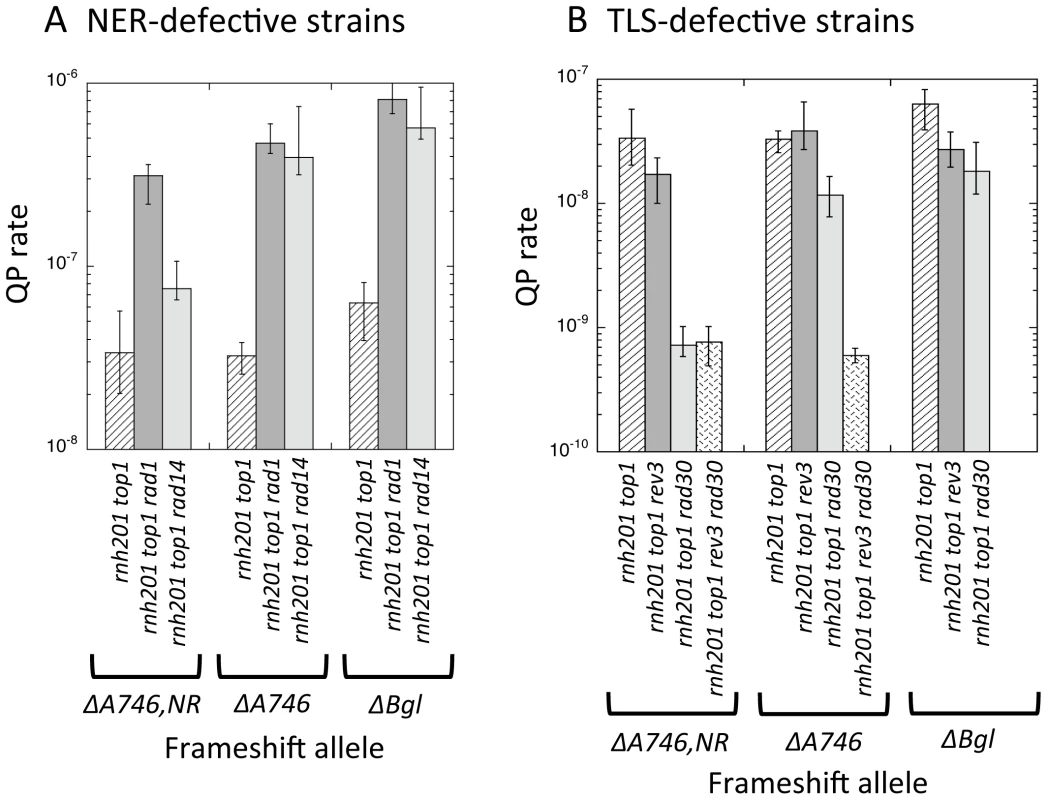
To discern whether the effect of Rad1 loss on QP mutations reflects the role of Rad1–Rad10 during NER, we examined the effect of disrupting Rad14, the homolog of mammalian XPA. Rad14 is required for the damage recognition step of NER and its loss eliminates NER in yeast, but not other functions of the Rad1–Rad10 complex. For the QP mutations identified in the lys2ΔA746 and lys2ΔBgl assays, there was no discernable difference between the rates of these events in the rnh201Δ top1Δ rad14Δ versus rnh201Δ top1Δ rad1Δ strains (Figure 4A). In the lys2ΔA746,NR assay, however, the rate of QP mutations in the rnh201Δ top1Δ rad14Δ background was only 2.2-fold higher than in the rnh201Δ top1Δ background, significantly less than the 9-fold increase observed in the rnh201Δ top1Δ rad1Δ background. The QP events identified in the lys2ΔA746 and lys2ΔBgl assays are thus limited by NER, while those detected in the lys2ΔA746,NR assay reflect primarily an NER-independent role of Rad1–Rad10.
Translesion synthesis (TLS) DNA polymerases are important for generating QP mutations
Prior analyses of transcription-associated mutagenesis in the lys2ΔA746 reversion assay suggest that most events reflect DNA-damage bypass by the Pol ζ TLS DNA polymerase [34], [40]. To examine whether rNMP-dependent QP mutations similarly require Pol ζ activity, we eliminated the Rev3 catalytic subunit of the enzyme in rnh201Δ top1Δ strains. In an rnh201Δ top1Δ rev3Δ background, the rate of QP mutations in the lys2ΔA746,NR or lys2ΔBgl assay was reduced ∼2-fold, while that in the lys2ΔA746 assay was not significantly affected (Figure 4B). Given the small effect of Pol ζ loss, we examined whether Pol η, the other major TLS polymerase in yeast, might be relevant to rNMP-dependent QP mutations. In the lys2ΔA746,NR assay, deletion of the Pol η-encoding RAD30 gene was accompanied by a 50-fold reduction in the QP mutation rate. In the lys2ΔA746 and lys2ΔBgl assays, rates of QP mutations rates were reduced only ∼3-fold in a rad30Δ background. QP mutations detected using the lys2ΔA746 allele, however, were completely eliminated upon loss of both Pol ζ and Pol η (rnh201Δ top1Δ rev3Δ rad30Δ mutant; reversion of the lys2ΔBgl allele was not examined in this background). Altogether, the data indicate that generation of rNMP-dependent QP mutations requires the participation of Pol ζ and/or Pol η, with specific strand-switch events relying on individual TLS polymerases to different extents. Again, this is in contrast to the rates of rNMP- and Top1-dependent deletions in tandem repeats, which are not affected by loss of TLS polymerases.
Discussion
We previously reported two types of mutations that are specifically elevated by high levels of transcription in yeast. First, removal of uracil that replaces thymine in transcriptionally active DNA creates abasic sites that are bypassed in a mutagenic manner by Pol ζ, resulting in elevated TA to GC transversions [36], [40]. Second, small deletions in tandem repeats reflect Top1 activity, which is important for removing transcription-associated supercoils [19], [20]. Here, we report a third transcription-associated mutation signature comprised of complex sequence changes that extend the complementarity between two arms of a quasi-palindrome (QP). Transcription-associated QP mutations are greatly elevated in an RNase H2-defective (rnh201Δ) background and, therefore, are associated with the persistence of some type of RNA∶DNA hybrid. Though both transcription-associated short deletions and QP mutations are elevated in an rnh201Δ background, other genetic requirements for these two types of events are distinctly different (summarized in Table 3). Most notably, rNMP-dependent QP mutations are affected by the direction of replication-fork movement and require RNase H1 rather than Top1 activity. In addition, only QP mutations are limited by NER and are dependent on TLS polymerases.
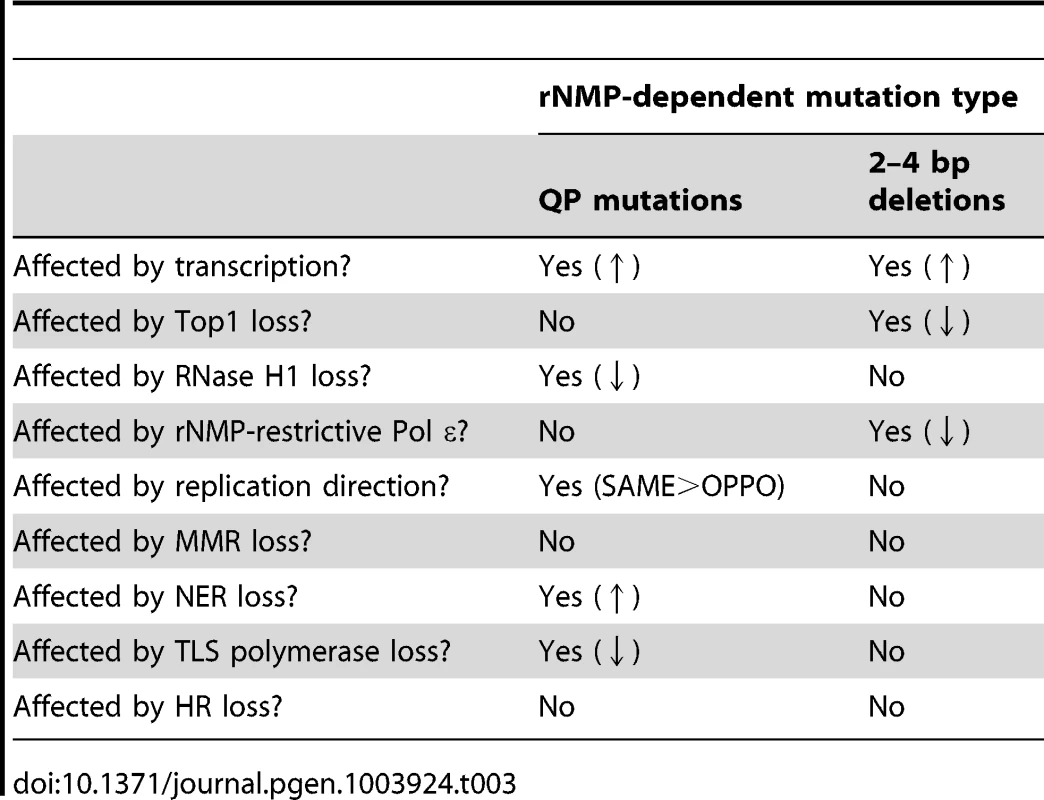
Complex sequence changes at QPs have been most extensively characterized in E. coli (reviewed in [30]), but also have been identified in bacteriophage T4 [41] and are found among TP53 gene mutations in human cancer cells [42]. A template-switch model for QP mutations was first proposed to explain unusual frameshift mutations in the yeast iso-1-cytochrome c gene [43], and we suggest that a similar mechanism is responsible for transcription-associated QP mutations. More recently, QP mutations in yeast have been shown to occur during the repair of DNA double-strand breaks via homologous recombination [44], [45]. Homologous recombination cannot be the source of the transcription-associated QP events observed here, however, as these events are not affected by loss of Rad52 (see Tables S1, S2), a protein essential for recombination in yeast (reviewed in [46]).
In bacterial studies, a strong effect of the direction of replication fork movement on a given QP mutation has been interpreted as evidence that the event primarily reflects either an intra-strand switch during lagging-strand synthesis or a transient inter-strand switch of a nascent leading strand to the lagging-strand template (see Figure 3). In either case, it is assumed that the switch is facilitated by the inherent single-strand character of the lagging-strand template and is precipitated by a block/pause during DNA synthesis. For example, there is a positive correlation between intrinsic DNA polymerase pause sites in vitro and QP-associated mutation hotspots in phage T4 [47]. In addition, QP-mediated mutations, but not simple base substitutions or frameshifts, are strongly stimulated by the nucleoside analog 3′-azidothymidine (AZT) in E. coli, which causes chain termination and replication stalling when incorporated by DNA polymerases [48]. Because transcription-associated QP mutation rates were much higher in the SAME than OPPO orientation, these events most likely reflect a problem encountered during lagging-strand synthesis. As will elaborated further below, the sensitivity of QP mutations to the direction of replication-fork movement may additionally reflect an orientation-dependent transcription-replication conflict.
In spite of the strong effect of replication direction on transcription-associated QP mutations, these events were not further stimulated by MMR loss and thus are unlikely to occur directly at the fork. Though this is in contrast to the removal of some types of QP mutation intermediates by MMR in E. coli [35], we note a similar MMR independence in the specific case of transcription-associated QP mutations [49]. One possible explanation for the MMR independence of transcription-associated QP mutations is that they arise during the filling of gaps that are left behind the fork when processive DNA synthesis is disrupted. Requirements of the yeast TLS polymerases for transcription-associated QP mutations (Figure 4B) would be consistent with such a post-replicative, gap-filling process. Indeed, it has been shown that other types of mutation intermediates introduced by Pol ζ are refractory to correction by the MMR machinery, and hence presumably arise outside the context of a replication fork [25]. Roles of the TLS polymerases during the formation of QP mutations could be in the relatively nonprocessive synthesis required for successive template switches and/or in extending mispaired primer-template termini that arise as a result of a template switch. Pol ζ, for example, is particularly good at extending primer-template mispairs [50].
In contrast to their strong stimulation upon RNase H2 loss, transcription-associated QP mutations are dependent on the presence of RNase H1. RNase H1 requires at least 3–4 contiguous rNMPs to incise the RNA component of RNA∶DNA hybrids, and we consider three possible sources of such hybrids. First, a DNA polymerase could mis-insert consecutive rNMPs during DNA synthesis. Though the major source of stochastic rNMP incorporation into the yeast genome appears to be due to Pol ε [6], expression of a mutant form of Pol ε with a reduced propensity to incorporate rNMPs did not significantly lower the rate of QP mutations. An alternative possibility that we cannot exclude is that one of the yeast TLS polymerases, each of which contributes to QP mutations (Figure 4), might be the source of the consecutive rNMPs that RNase H1 acts on. E. coli Pol V, for example, which is in the same polymerase family as yeast Pol η, is characterized by low discrimination between dNTPs and rNTPs [51]. A second source of more extended RNA∶DNA hybrids is the RNA primers used to initiate Okazaki fragments during lagging-strand synthesis. The major pathways for removing RNA primers appear to involve either the successive cleavage of short, Pol δ-displaced 5′ flaps by the Fen1 flap endonuclease or the cleavage of longer strand-displacement flaps by the combined action of Dna2 and Fen1 [5]. This does not exclude, however, an important role for RNases H1 and H2 in Okazaki primer removal in some circumstances, and a specific case relevant to QP mutations might be under high-transcription conditions. Finally, R-loops that form during transcription provide a third source of RNA∶DNA hybrids that are potential substrates of RNase H1. The opposing roles of RNase H1 and H2 in the generation of QP mutations (a reduction and increase upon deletion of RNH1 and RNH201, respectively) suggest that RNase H1 likely degrades most of the RNA component of the relevant RNA∶DNA hybrid, leaving a small number of rNMPs that can only be removed by RNase H2. It is then the persistence of one or a few rNMPs that is assumed to perturb lagging-strand synthesis and eventually precipitate the intra-strand template switch that leads to QP mutations. We note that the type of template switch proposed here would only allow a small number of blocking rNMPs to be bypassed. Longer RNA-DNA hybrids presumably lead to a different type of instability that cannot be detected in our reversion assays.
A final feature of the transcription-associated QP mutations described here is their elevation upon loss of the NER pathway, suggesting that removal of some type of helical distortion or secondary structure limits these events. Helical distortion could reflect DNA damage or the presence of consecutive rNMPs in duplex DNA [52], while the hairpin formed during an intra-strand template switch might be a relevant secondary structure. In addition to a general role for NER in preventing QP mutations, an NER-independent role for Rad1 was evident in the lys2ΔA746,NR assay. We speculate that the NER independence reflects the well-known role of Rad1–Rad10 in removing 3′ flaps [38], which may be analogous to the role of 3′ to 5′ single-strand exonucleases in preventing QP mutations in E. coli [35]. Whether other endo- or exo-nucleases are relevant to QP mutations in yeast remains to be explored.
Based on the genetic requirements of transcription-associated QP mutations, we entertain two different models for how these events might arise in yeast (Figure 5). Central to both models is an involvement of an RNA∶DNA hybrid and an effect of the direction of replication-fork movement. In the first model, replication stalling and subsequent strand misalignment within a QP reflects a deficiency in Okazaki fragment maturation in the absence of RNase H2 (Figure 5A). This would be consistent with the presumptive origin of QP mutations during lagging-strand synthesis and with the apparent site-specificity of these mutations, which could reflect the position of an Okazaki fragment-priming site. There are, for example, additional QPs in the reversion window monitored that should be able to template complex mutations, but corresponding QP mutations were not detected at these positions. The involvement of NER could reflect processing of a hairpin intermediate formed during the template switch, while an NER-independent role of Rad1–10 could reflect removal of unpaired 3′ ends during an attempted template switch [35]. A prediction of this model is that QP mutations should be exacerbated by additional perturbation in Okazaki fragment synthesis and/or processing.
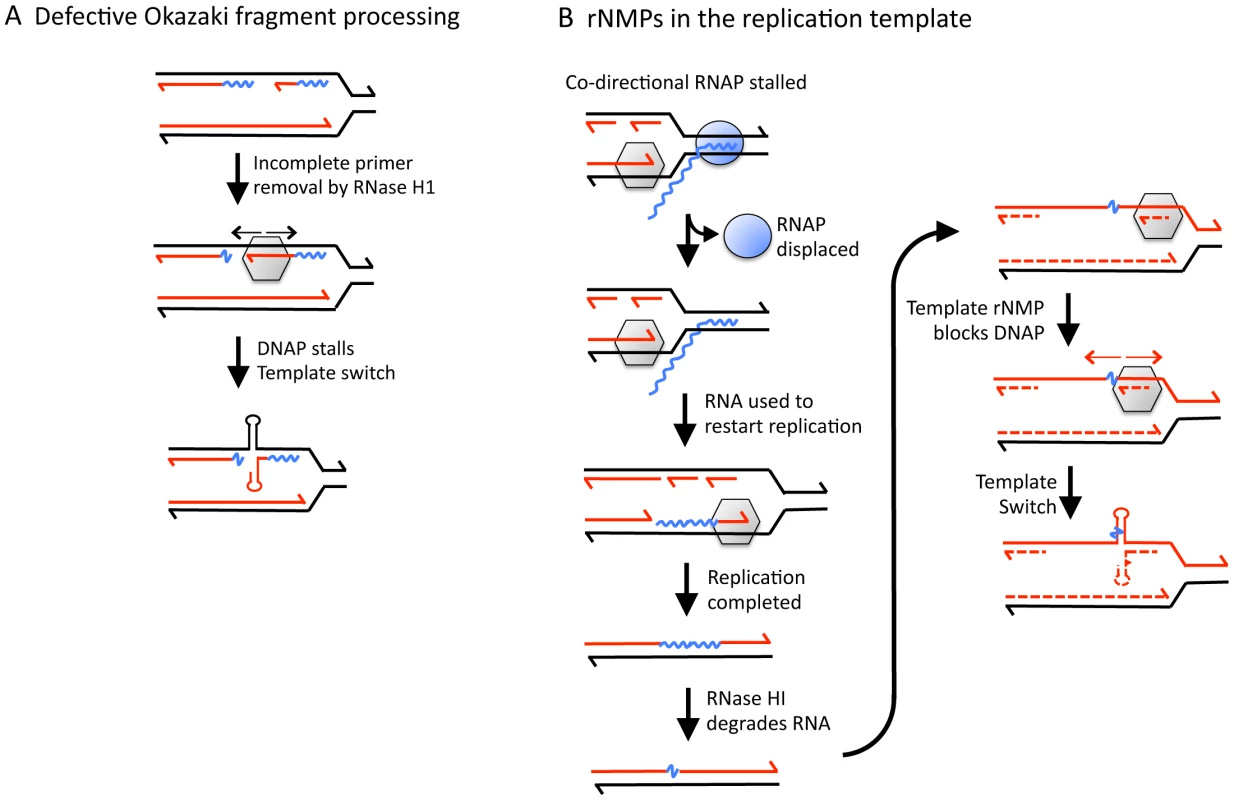
A second model (Figure 5B) is suggested by in vitro studies of replication-transcription conflicts using bacterial proteins, in which co-directional collisions disrupt both DNA and RNA synthesis. Significantly, the transcript can be used as a primer to re-start leading-strand replication [53]. Recent studies in E. coli have corroborated these findings and suggest that co-directional collisions with backtracked/arrested RNA polymerase are particularly problematic [54]. Following replication re-start, a failure to properly process the primer would lead to transcript-derived rNMPs in the lagging-strand template at the next round of replication. rNMP-provoked replication stalling could trigger formation of an rNMP-containing gap that would need to be filled post-replicatively, leading to the observed QP mutations. For yeast DNA polymerases, the efficiency of rNMP bypass varies depending on the sequence context [55], and this might account for the site-specificity of events. With regard to the role of NER in limiting QP mutations, pausing/stalling of the transcription machinery at damage that is normally removed by NER would be expected to increase co-directional collisions. More frequent collisions should also be promoted by mutations that slow the elongation rate of RNA polymerase or that eliminate anti-backtracking mechanisms. This model could be tested by examining the effect of eliminating transcription elongation factor TFIIS, which also reactivates backtracked RNA polymerase [56].
Ribonucleotides are likely the most prevalent, non-canonical component of genomic DNA and can lead to catastrophic events in the absence of efficient removal [7]. In addition to Top1-generated strand breaks at rNMPs, which lead to short deletions [18] and replication stress [57], the QP mutations described here underscore the importance of efficient rNMP removal by RNase H2 for the maintenance of genome integrity. The more extensive palindromes generated by QP mutations can fold into stable secondary structures such as hairpins and cruciforms, which would further increase the risk of genome instability. Additional studies will be required to understand the molecular mechanism whereby transcription perturbs the processing and/or promotes formation of RNA∶DNA hybrids that lead to QP mutations in yeast.
Materials and Methods
Media and growth conditions
Yeast strains were grown at 30°C in non-selective YEP medium (1% yeast extract, 2% peptone; 2% agar for plates) supplemented with 2% dextrose (YEPD) or with 2% each of glycerol and ethanol (YEPGE). pTET was maximally activated under these growth conditions, and was repressed by addition of doxycycline (Sigma) to 2 µg/ml. Selective growth was on synthetic, 2% dextrose (SD) medium supplemented with all but one nutrient. Selection of hygromycin- or nourseothricin-resistant transformants was on YEPD plates containing 300 µg/ml hygromycin (Mediatech) or 100 µg/ml nourseothricin (Axxora), respectively.
Strain constructions
Yeast strains were derived from YPH45 (MATα ura3-52 ade2-101oc trp1Δ1). Deletion of the LYS2 locus and introduction of the pTET-lys2ΔA746, pTET-lys2ΔBgl, or pTET-lys2ΔA746,NR allele near ARS306 on Chromosome III was previously described [18], [20], [34]. The pol2-M644L mutation was introduced by two-step allele replacement using plasmid p173 [17]. Genes were deleted using PCR-generated cassettes containing a selectable marker flanked by ∼60 bp of homology. As appropriate, marker genes flanked by loxP sites were deleted using a Cre-expressing plasmid [58].
Mutation rates and spectra
One-ml YEPGE cultures were inoculated with 250,000 cells and grown for 3 days. Appropriate dilutions were plated on YEPD or SD-Lys plates to determine the total number of cells or the number of Lys+ revertants, respectively, in each culture. Data from 10–24 cultures were used to calculate each mutation rate using the method of the median [59], and corresponding 95% confidence intervals were determined as described previously [60]. To construct mutation spectra, we isolated independent Lys+ revertants from 0.3-ml YEPGE cultures inoculated from single colonies. Following isolation of genomic DNA, the relevant region of LYS2 was PCR amplified and sequenced by the Duke University DNA Analysis Facility.
Supporting Information
Zdroje
1. AguileraA, Garcia-MuseT (2012) R loops: from transcription byproducts to threats to genome stability. Mol Cell 46: 115–124.
2. LiX, ManleyJL (2006) Cotranscriptional processes and their influence on genome stability. Genes Dev 20: 1838–1847.
3. KimN, Jinks-RobertsonS (2012) Transcription as a source of genome instability. Nat Rev Genet 13: 204–214.
4. BurgersPM (2009) Polymerase dynamics at the eukaryotic DNA replication fork. J Biol Chem 284: 4041–4045.
5. ZhengL, ShenB (2011) Okazaki fragment maturation: nucleases take centre stage. J Mol Cell Biol 3: 23–30.
6. Nick McElhinnySA, WattsBE, KumarD, WattDL, LundstromEB, et al. (2010) Abundant ribonucleotide incorporation into DNA by yeast replicative polymerases. Proc Natl Acad Sci USA 107: 4949–4954.
7. ReijnsMA, RabeB, RigbyRE, MillP, AstellKR, et al. (2012) Enzymatic removal of ribonucleotides from DNA is essential for mammalian genome integrity and development. Cell 149: 1008–1022.
8. CerritelliSM, CrouchRJ (2009) Ribonuclease H: the enzymes in eukaryotes. FEBS J 276: 1494–1505.
9. OhtaniN, HarukiM, MorikawaM, CrouchRJ, ItayaM, et al. (1999) Identification of the genes encoding Mn2+-dependent RNase HII and Mg2+-dependent RNase HIII from Bacillus subtilis: classification of RNases H into three families. Biochemistry 38: 605–618.
10. ChonH, SparksJL, RychlikM, NowotnyM, BurgersPM, et al. (2013) RNase H2 roles in genome integrity revealed by unlinking its activities. Nucleic Acids Res 41 ((5)): 3130–43.
11. CerritelliSM, FrolovaEG, FengC, GrinbergA, LovePE, et al. (2003) Failure to produce mitochondrial DNA results in embryonic lethality in RNaseh1 null mice. Mol Cell 11: 807–815.
12. JeongHS, BacklundPS, ChenHC, KaravanovAA, CrouchRJ (2004) RNase H2 of Saccharomyces cerevisiae is a complex of three proteins. Nucleic Acids Res 32: 407–414.
13. SparksJL, ChonH, CerritelliSM, KunkelTA, JohanssonE, et al. (2012) RNase H2-initiated ribonucleotide excision repair. Mol Cell 47: 980–986.
14. ReaganMS, PittengerC, SiedeW, FriedbergEC (1995) Characterization of a mutant strain of Saccharomyces cerevisiae with a deletion of the RAD27 gene, a structural homolog of the RAD2 nucleotide excision repair gene. J Bacteriol 177: 364–371.
15. LazzaroF, NovarinaD, AmaraF, WattDL, StoneJE, et al. (2012) RNase H and postreplication repair protect cells from ribonucleotides incorporated in DNA. Mol Cell 45: 99–110.
16. CrowYJ, LeitchA, HaywardBE, GarnerA, ParmarR, et al. (2006) Mutations in genes encoding ribonuclease H2 subunits cause Aicardi-Goutières syndrome and mimic congenital viral brain infection. Nature Genet 38: 910–916.
17. Nick McElhinnySA, KumarD, ClarkAB, WattDL, WattsBE, et al. (2010) Genome instability due to ribonucleotide incorporation into DNA. Nat Chem Biol 6: 774–781.
18. KimN, HuangSY, WilliamsJS, LiYC, ClarkAB, et al. (2011) Mutagenic processing of ribonucleotides in DNA by yeast topoisomerase I. Science 332: 1561–1564.
19. ChoJE, KimN, LiYC, Jinks-RobertsonS (2013) Two distinct mechanisms of Topoisomerase 1-dependent mutagenesis in yeast. DNA Repair 12 ((3)): 205–11.
20. LippertMJ, KimN, ChoJE, LarsonRP, SchoenlyNE, et al. (2011) Role for topoisomerase 1 in transcription-associated mutagenesis in yeast. Proc Natl Acad Sci USA 108: 698–703.
21. PommierY, PourquierP, FanY, StrumbergD (1998) Mechanism of action of eukaryotic DNA topoisomerase I and drugs targeted to the enzyme. Biochim Biophys Acta 1400: 83–105.
22. SekiguchiJ, ShumanS (1997) Site-specific ribonuclease activity of eukaryotic DNA topoisomerase I. Mol Cell 1: 89–97.
23. GreeneCN, Jinks-RobertsonS (1997) Frameshift intermediates in homopolymer runs are removed efficiently by yeast mismatch repair proteins. Mol Cell Biol 17: 2844–2850.
24. HarfeBD, Jinks-RobertsonS (1999) Removal of frameshift intermediates by mismatch repair proteins in Saccharomyces cerevisiae. Mol Cell Biol 19: 4766–4773.
25. LehnerK, Jinks-RobertsonS (2009) The mismatch repair system promotes Polζ-dependent translesion synthesis in yeast. Proc Natl Acad Sci USA 106: 5749–5754.
26. ChenJZ, QiuJ, ShenB, HolmquistGP (2000) Mutational spectrum analysis of RNase H(35) deficient Saccharomyces cerevisiae using fluorescence-based directed termination PCR. Nucleic Acids Res 28: 3649–3656.
27. TurchiJJ, HuangL, MuranteRS, KimY, BambaraRA (1994) Enzymatic completion of mammalian lagging-strand DNA replication. Proc Natl Acad Sci USA 91: 9803–9807.
28. QiuJ, QianY, FrankP, WintersbergerU, ShenB (1999) Saccharomyces cerevisiae RNase H(35) functions in RNA primer removal during lagging-strand DNA synthesis, most efficiently in cooperation with Rad27 nuclease. Mol Cell Biol 19: 8361–8371.
29. RipleyLS (1990) Frameshift mutation: determinants of specificity. Annu Rev Genet 24: 189–213.
30. LovettST (2004) Encoded errors: mutations and rearrangements mediated by misalignment at repetitive DNA sequences. Molecular Microbio 52: 1243–1253.
31. TrinhTQ, SindenRR (1991) Preferential DNA secondary structure mutagenesis in the lagging strand of replication in E. coli. Nature 352: 544–547.
32. RoscheWA, RipleyLS, SindenRR (1998) Primer-template misalignments during leading strand DNA synthesis account for the most frequent spontaneous mutations in a quasipalindromic region in Escherichia coli. J Mol Biol 284: 633–646.
33. YoshiyamaK, HiguchiK, MatsumuraH, MakiH (2001) Directionality of DNA replication fork movement strongly affects the generation of spontaneous mutations in Escherichia coli. J Mol Biol 307: 1195–1206.
34. KimN, AbdulovicAL, GealyR, LippertMJ, Jinks-RobertsonS (2007) Transcription-associated mutagenesis in yeast is directly proportional to the level of gene expression and influenced by the direction of DNA replication. DNA Repair 6: 1285–1296.
35. ViswanathanM, LacirignolaJJ, HurleyRL, LovettST (2000) A novel mutational hotspot in a natural quasipalindrome in Escherichia coli. J Mol Biol 302: 553–564.
36. KimN, Jinks-RobertsonS (2009) dUTP incorporation into genomic DNA is linked to transcription in yeast. Nature 459: 1150–1153.
37. BoiteuxS, Jinks-RobertsonS (2013) DNA repair mechanisms and the bypass of DNA damage in Saccharomyces cerevisiae. Genetics 193: 1025–1064.
38. LyndakerAM, AlaniE (2009) A tale of tails: insights into the corrdination of 3′ end processing during homologous recombination. Bioessays 31: 315–321.
39. LinY, WilsonJH (2012) Nucleotide excision repair, mismatch repair, and R-loops modulate convergent transcription-induced cell death and repeat instability. PloS One 7: e46807.
40. KimN, Jinks-RobertsonS (2010) Abasic sites in the transcribed strand of yeast DNA are removed by transcription-coupled nucleotide excision repair. Mol Cell Biol 30: 3206–3215.
41. de BoerJG, RipleyLS (1984) Demonstration of the production of frameshift and base-substitution mutations by quasipalindromic DNA sequences. Proc Natl Acad Sci USA 81: 5528–5531.
42. GreenblattMS, GrollmanAP, HarrisCC (1996) Deletions and insertions in the p53 tumor suppressor gene in human cancers: confirmation of the DNA polymerase slippage/misalignment model. Cancer Res 56: 2130–2136.
43. RipleyLS (1982) Model for the participation of quasi-palindromic DNA sequences in frameshift mutation. Proc Natl Acad Sci USA 79: 4128–4132.
44. HicksWM, KimM, HaberJE (2010) Increased mutagenesis and unique mutation signature associated with mitotic gene conversion. Science 329: 82–85.
45. DeemA, KeszthelyiA, BlackgroveT, VaylA, CoffeyB, et al. (2011) Break-induced replication is highly inaccurate. PLoS Biol 9: e1000594.
46. SymingtonLS (2002) Role of RAD52 epistasis group genes in homologous recombination and double-strand break repair. Microbiol Mol Biol Rev 66: 630–670.
47. PapanicolaouC, RipleyLS (1991) An in vitro approach to identifying specificity determinants of mutagenesis mediated by DNA misalignments. J Mol Biol 221: 805–821.
48. SeierT, ZilberbergG, ZeigerDM, LovettST (2012) Azidothymidine and other chain terminators are mutagenic for template-switch-generated genetic mutations. Proc Natl Acad Sci USA 109: 6171–6174.
49. YoshiyamaK, MakiH (2003) Spontaneous hotspot mutations resistant to mismatch correction in Escherichia coli: transcription-dependent mutagenesis involving template-switching mechanisms. J Mol Biol 327: 7–18.
50. PrakashS, PrakashL (2002) Translesion DNA synthesis in eukaryotes: a one- or two-polymerase affair. Genes Dev 16: 1872–1883.
51. McDonaldJP, VaismanA, KubanW, GoodmanMF, WoodgateR (2012) Mechanisms employed by Escherichia coli to prevent ribonucleotide incorporation into genomic DNA by Pol V. PLoS Genet 8: e1003030.
52. WahlMC, SundaralingamM (2000) B-form to A-form conversion by a 3′-terminal ribose: crystal structure of the chimera d(CCACTAGTG)r(G). Nucleic Acids Res 28: 4356–4363.
53. PomerantzRT, O'DonnellM (2008) The replisome uses mRNA as a primer after colliding with RNA polymerase. Nature 456: 762–766.
54. DuttaD, ShatalinK, EpshteinV, GottesmanME, NudlerE (2011) Linking RNA polymerase backtracking to genome instability in E. coli. Cell 146: 533–543.
55. WattDL, JohanssonE, BurgersPM, KunkelTA (2011) Replication of ribonucleotide-containing DNA templates by yeast replicative polymerases. DNA Repair 10: 897–902.
56. WindM, ReinesD (2000) Transcription elongation factor SII. BioEssays 22: 327–336.
57. WilliamsJS, SmithDJ, MarjavaaraL, LujanSA, ChabesA, et al. (2013) Topoisomerase 1-mediated removal of ribonucleotides from nascent leading-strand DNA. Mol Cell 49 ((5)): 1010–5.
58. GueldenerU, HeinischJ, KoehlerGJ, VossD, HegemannJH (2002) A second set of loxP marker cassettes for Cre-mediated multiple gene knockouts in budding yeast. Nucleic Acids Res 30: e23.
59. LeaDE, CoulsonCA (1949) The distribution of the numbers of mutants in bacterial populations. J Genet 49: 264–285.
60. Spell RM, Jinks-Robertson S (2004) Determination of mitotic recombination rates by fluctuation analysis in Saccharomyces cerevisiae. In: Waldman AS, editor. Genetic Recombination: Reviews and Protocols. Totowa, NJ: Humana Press. pp. 3–12.
Štítky
Genetika Reprodukčná medicínaČlánok vyšiel v časopise
PLOS Genetics
2013 Číslo 11
- Je „freeze-all“ pro všechny? Odborníci na fertilitu diskutovali na virtuálním summitu
- Gynekologové a odborníci na reprodukční medicínu se sejdou na prvním virtuálním summitu
Najčítanejšie v tomto čísle
- Genetic and Functional Studies Implicate Synaptic Overgrowth and Ring Gland cAMP/PKA Signaling Defects in the Neurofibromatosis-1 Growth Deficiency
- RNA∶DNA Hybrids Initiate Quasi-Palindrome-Associated Mutations in Highly Transcribed Yeast DNA
- The Light Skin Allele of in South Asians and Europeans Shares Identity by Descent
- Roles of XRCC2, RAD51B and RAD51D in RAD51-Independent SSA Recombination
